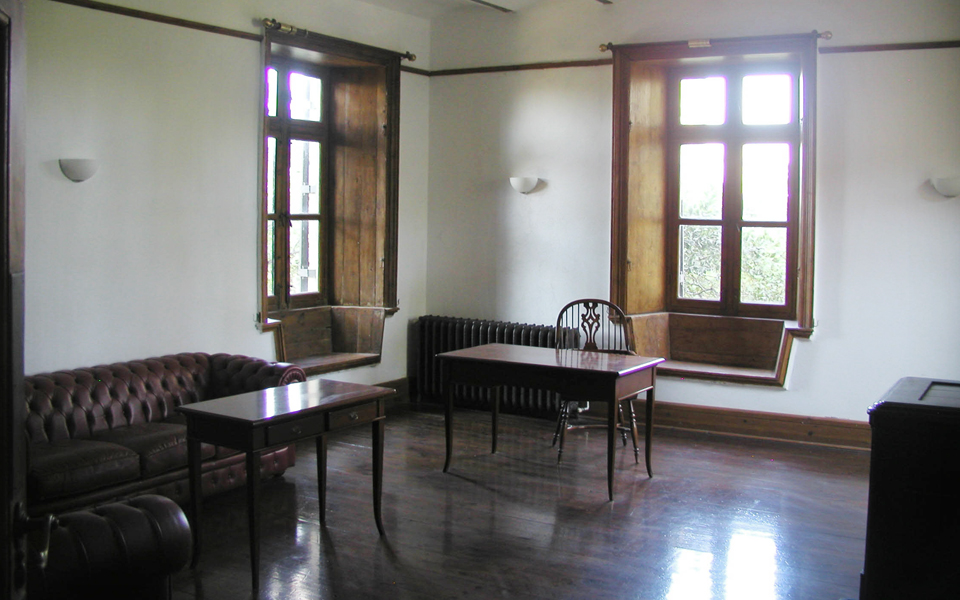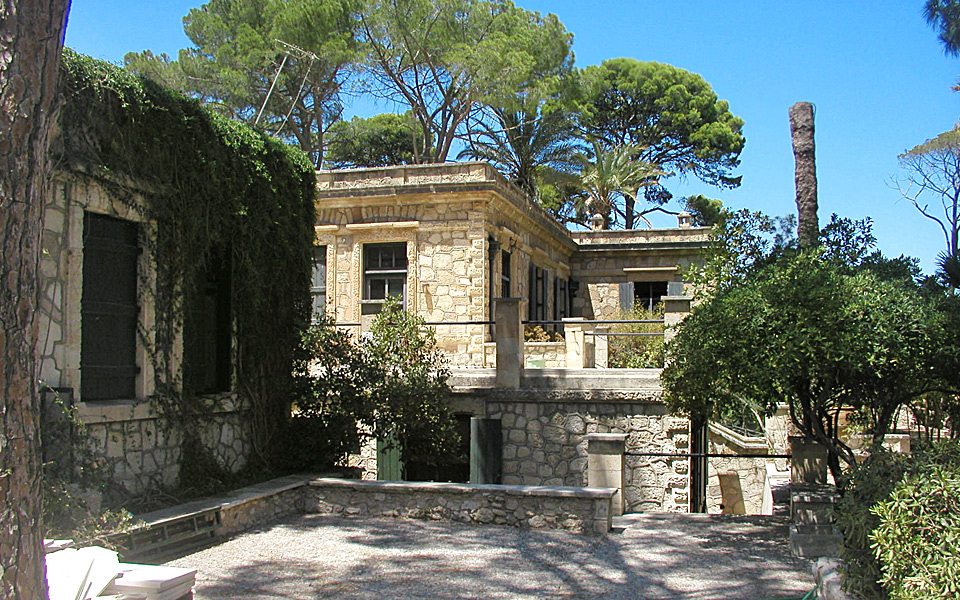In the dying years of Ottoman rule in Crete, two British gentlemen shared food on a hillside overlooking the Kephala mound at Knossos. One said to his friend – This is where I shall live when I come to dig Knossos. As Arthur Evans planned, so he often did. But this time, not immediately. The excavation finally began in 1900: Evans and his team lived first south of the Palace, by the stream. They very soon left – mosquitoes and the fear of malaria. Next they resided in Herakleion. But by 1905 they had tired of the daily two-hour trek – and the relentless disappearance of blankets. So Evans commissioned Christian Doll, then his site surveyor, to bring into being the Villa Ariadne – on the self-same spot chosen a decade before.
Doll was barely in his 20s, when he began in 1906. It took him just over a year of daily commuting from Herakleion: he was routinely soaked (and ‘not feeling very well’) or roasted by African winds, and once accosted and harassed by a madman at the city gates. At happier moments, he snared butterflies in his cap when walking to work: like many young men then, he was an avid collector. The construction was not straightforward: he faced problems from supplies of unacceptable quality, disagreements in pay rates, the loss of expensive imported steel-girders in Herakleion harbour. Nor was he always in Evans’ good books, which upset him a great deal. But persevere he did: in due course the Villa was finished and furnished up to a point. The garden was planted out: all the trees were imported from the mainland. The first batch was ravaged by a storm immediately on arrival.
By 1907 much of the initial burst of excavation was achieved. The Villa did duty as a Dig-House, but was equally an establishment for scholarly research and living. Existence was not impossibly Spartan. Evans himself imported many necessities (such as marmalades, tinned meats and spirits) straight from Fortnum and Masons, preferring to drink French reds to the Cretan ‘brown’. Life flowed on pleasantly to 1914, then ceased for the duration of the First World War. The Villa was not abandoned: a Greek major-domo remained, awaiting a resumption of normality.
“The Villa did duty as a Dig-House, but was equally an establishment for scholarly research and living.”

“Piet de Jong with his penchant for a Good Story used to regale audiences with an account of how MacKenzie’s ghost, accompanied by a woman, visited the Villa on the night of his death.”
After 1918, the pace picked up again. Evans, now in his late 60s, produced the first volume of his magisterial work on the Bronze Age of Crete (1921). Rich though he now was, he began to feel the financial strain. In 1922, he wrote – I am trying to carry out a scheme for handing over the house and the site to the British School. This had been agreed upon by 1924, and implemented by 1926. Along with the creation – at his expense – of a Curatorship to organize matters at Knossos: the holder to reside in the Villa. A smaller residence on his estate, aka the Taverna, was extensively refurbished in 1928. The first Curator was the loyal Duncan MacKenzie, to be replaced in 1930 by the recently married John Pendlebury. The tone changed: the Villa had become an outpost of the School in Athens. Students and scholars paid to stay there, to use it as a base for studies throughout the island. Meals were taken there; a Library established. Eye-witness accounts describe it as somewhat stripped of its former furnishings and splendor.
Of course, Evans still often descended for spring and early summer, working on his books or chasing something to excavate. Then there was a revival, if brief, of former glory-days! In 1926, for example, he hosted in one month three groups of visiting Britons – each 100-150 strong, including some of the Great and Good of the time. But such events dropped away in the 1930s: Evans at 80 years was not so spry as before. His last visit was in 1935: when he was honored by the Cretans. An estimated 10,000 people turned up at the Palace, dismaying Evans, who was distraught at not being able to offer them all hospitality.
In 1935 too Mackenzie died in Italy. Piet de Jong with his penchant for a Good Story used to regale audiences with an account of how MacKenzie’s ghost, accompanied by a woman, visited the Villa on the night of his death – causing de Jong a disturbing Out-of-Body experience. Others have since claimed to have heard the ghost.


At the outbreak of WW II, ‘Squire’ Hutchinson was Curator, with his mother. He resided down the path in the Taverna, further emptying the Villa of life. On the withdrawal of the Allies to Crete in Spring 1941, and with an imminent German invasion by sea feared, the Villa experienced a flurry of unusual activity. The King of the Hellenes, George II, stayed briefly, en route to Egypt and safety. In late April, Hutchinson, and mother, departed Crete too. The Allied Field Hospital smartly moved in, relocating from unsatisfactory and vulnerable quarters down Herakleion way. They found the Villa empty of people – eerily a few sherds and objects sat about still.
On the morning of the Invasion, the Villa inhabitants had a ring-side view of the unfolding struggle. In the morning they were able to look down into the the German planes, as they attacked Herakleion. In the afternoon, the great gliders dropped their paratroopers amidst aerial explosions and much loss of life. Intense and localized fighting erupted across the landscape, as the Cretans waded in too. The Villa began receiving its first casualties: Cretan, German and Allied alike.
Many anecdotes are remembered of the next few days. The wounded patients lying on mattresses in the gardens, as well as the Villa; a Cretan with a row of bullet holes across his upper torso, wrapped in his greatcoat so that no-one realized, stoically uncomplaining; a Scots soldier, with a bullet in his brain, wandering around nude for a day or two, talking non-stop nonsense until the end. The Germans were not sure who held the Villa (no Red Cross was shown) – they mortared it: two exploded at roof level, blowing out doors and windows. A third cut down a young British private-cum-orderly, running down the outside steps to check the patients in the garden. Eventually, as the Germans gained control, the Villa was ‘captured’, without a shot naturally. The German officer in charge – on understanding the Villa’s role – was profuse in his thanks for the professional and humane behaviour shown by the Allied Medical team.
Establishing their control, the Germans created a divisional HQ up at Archanes, but retained the Villa as the Living Quarters for the Commanding General. It became something of an armed camp – inevitably, for fear of revenge attacks. Foxholes were dug around the perimeter, which was garlanded with barbed wire; massive underground bunkers were excavated behind the Villa. Their defences were however flawed: a Cretan house on their perimeter offered a view into the compound. Notice was taken of German routines. Eventually in 1944, this information became part of the planning for the kidnapping of the German General Kreipe on his way home to the Villa. This was successfully carried out (Ill Met by Moonlight).
“Intense and localized fighting erupted across the landscape, as the Cretans waded in too. The Villa began receiving its first casualties: Cretan, German and Allied alike.”

The pay-back extracted by the Germans was severe. But the endgame was approaching fast. By October 1944, Herakleion was in Allied hands (with the Germans bottled up around Chania). Now the Villa became an Allied military HQ. In May 1945, the last official surrender of the war in Europe by the German-Italian forces was signed in a room in the Villa. (A simple marble plaque in its main hall records the event.) The Liaison Officer to the British Military Mission in Crete was then stationed there, along with sundry Army and Air Force senior personnel.
The Villa then passed back into the nominal control of the British School in late 1947. The system of a resident Curatorship was restored. The de Jongs took it on: they returned to a changed world. It was now inappropriate for Foreign Schools to retain so much of Greek property – let alone a site of such importance. The financial impossibility of discharging one’s responsibilities properly demanded consideration. Rapidly the British School contemplated and executed their withdrawal from Knossos, as ‘owners’ at least. In 1951 the Committee resolved to hand Evans’ erstwhile estate to the Greek State. What Villa furnishing remained and was desired was transferred down to the Taverna, along with the library. Here henceforth was the centre of British activity, still intense. By 1955 all official business had been achieved: the School was ‘proud to hand over to the Greek Archaeological Service’ – an act overseen by the then Director, Sinclair Hood. The School was still able to ask for certain access to the Villa in times of excavation and similar events.
In the threescore years since that day, the Villa has never been abandoned. Sometimes busier, at others dormant. Always a Greek phylax lives there, to keep an eye on it .. and the British down at the Taverna. It has housed students and scholars on an almost yearly basis. Conferences have been run there, temporary offices set up for some segment of the Greek Archaeological Service, rooms held for visiting manadrins from Athens. Its upkeep, after a century of existence a not negligible undertaking, has been regularly attended to at considerable expense by the Greek State. It is not a simple task: the original woodwork and metalwork are deteriorating; earthquakes have opened cracks; the major trees are at the end of their lives. Of Evans’ furnishings (only his huge footed bathtub imported from the UK remains), most have long since perished due to time, chance and gnawing insects. It can feel like a sad shell. But as Dilys Powell (The Villa Ariadne) astutely observed a few decades back: half-naked though it was, Evans’s house looked immortal. May it remain so!
“In the threescore years since that day, the Villa has never been abandoned. Sometimes busier, at others dormant. ”












